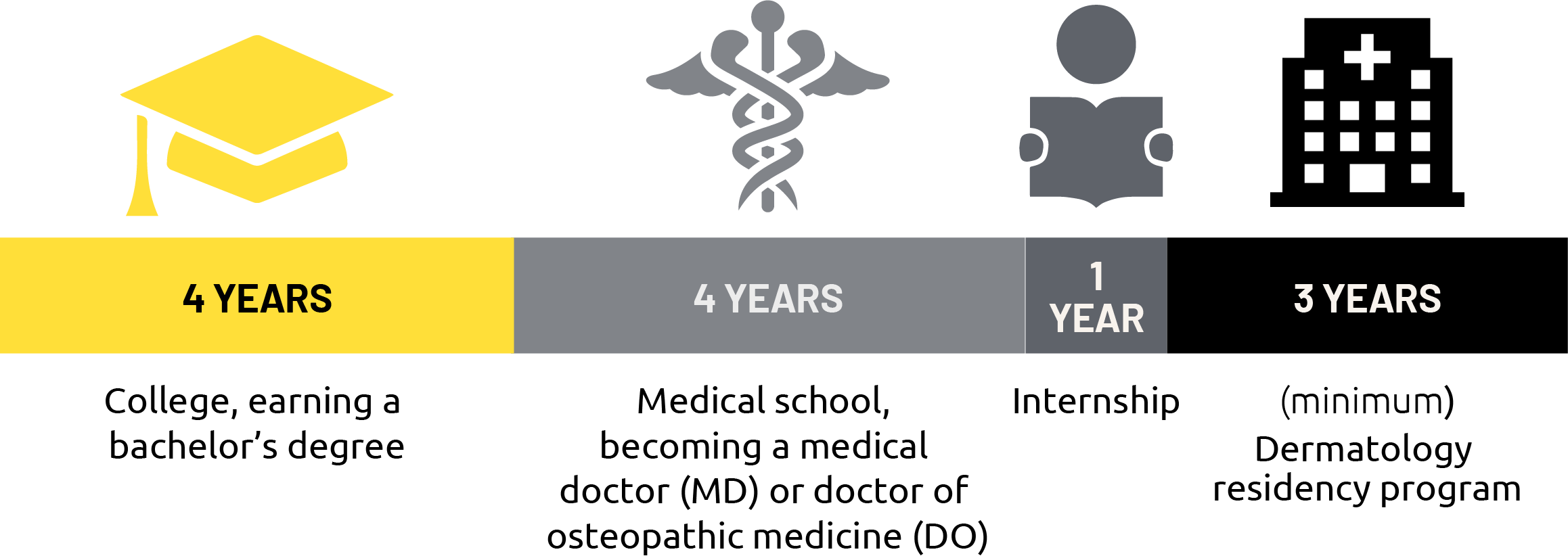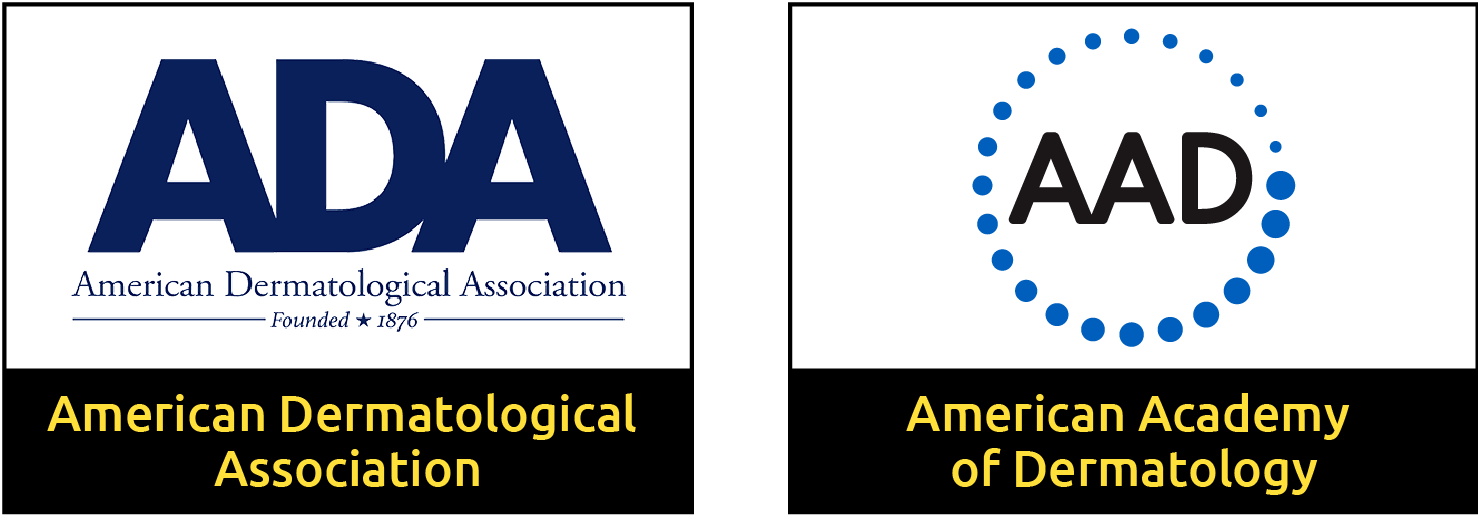

Introduction to Lesson 1
Dermatologists are highly trained doctors who diagnose and treat conditions that affect skin. Dermatologists can provide medical treatments, perform minor to more extensive surgeries, and many perform cosmetic procedures.
Here, we define dermatology as a practice, review the training of these clinicians, and take a look at the major dermatology societies.
Who Are Dermatologists?
General dermatologists see a wide range of conditions and can treat patients both medically and surgically. They are intimately involved not only in the diagnosis and management of disease, but also the care and protection of normal skin. Dermatologists treat conditions that are limited to the skin as well as the skin manifestations of systemic diseases. They manage both the pathologic and cosmetic manifestations of skin disease, and play a central role in normal skin care, skin cancer prevention, and sun protection.4
Dermatologists are trained to diagnose and manage children and adults with benign and malignant disorders of the skin, mouth, external genitalia, hair, and nails. Many dermatologists can also manage sexually transmitted diseases. While dermatologists can recognize and manage thousands of conditions, some of the more common and consequential conditions they see include skin cancers, melanomas, moles, and other tumors of the skin, contact dermatitis, and other allergic and nonallergic skin disorders, such as psoriasis. Dermatologists can recognize the skin manifestations of systemic and infectious diseases.4
Dermatologists also have special training in dermatopathology–the diagnosis of infectious, immunologic, degenerative, and neoplastic skin diseases–and in a broad range of surgical techniques used to treat the skin and associated structures.4
The care of the dermatology patient may entail both topical and systemic medical therapeutics and a variety of surgical and cosmetic procedures, including excisions, sclerotherapy, laser surgery, liposuction, hair transplants and tissue augmentation therapies, anti-aging treatments, injectable and implantable soft tissue fillers, correction of acne scarring, chemical peeling, vein therapy, skin cancer treatment, and reconstructive flaps and grafts.4

What Training Does a Dermatologist Have?
Dermatologists must complete extensive training to address health and cosmetic issues related to the skin, hair, and nails. Before they can begin practicing, dermatologists require more than a decade of education and training, including1,5:
- Four years of college to earn a bachelor's degree
- Four years of medical school to become a medical doctor. The vast majority of dermatologists have graduated from conventional medical schools, however, a small percentage are graduates of osteopathic schools
- An internship of at least 1 year
- A minimum of 3 years of residency, working alongside experienced doctors and completing between 12,000 and 16,000 hours of treating patients

Dermatology Board Certification
After completing a residency, dermatologists can become board certified by completing an exam on the knowledge and skills acquired during training. The 3 major certifying boards in the United States and Canada are the American Board of Dermatology, the American Osteopathic Board of Dermatology, and the Royal College of Physicians and Surgeons of Canada.1 Board-certified dermatologists can be identified by the letters “FAAD” as part of their titles. This stands for “Fellow of the American Academy of Dermatology.”1 In order to continue to be board certified, dermatologists must pass the board exam every 10 years, or participate in an ongoing, monitored self-assessment.6

Dermatology Subspecialties
There is no dermatology specialty that is focused exclusively on psoriasis, although there are some clinicians who have a particular interest in psoriasis and who have built their practices around this condition. The 3 major American Board of Dermatology-approved subspecialities include dermatopathology, procedural dermatology, and pediatric dermatology.5
Select each button to learn more about dermatology subspecialties.
Dermatopathologists, who specialize in the pathology of the skin, can have underlying training as a pathologist or dermatologist who specializes in the pathology of the skin. In general, these specialists complete a 1-year dermatopathology fellowship.5
Procedural dermatologists perform excision surgeries, including Mohs surgery, a specialized type of microscopically controlled surgery used for treating certain skin cancers. Physicians trained in this technique require knowledge of both pathology and surgery. Physicians who perform Mohs surgery can receive training in this specialized technique during their dermatology residency, but many will seek additional training either through preceptorships to join the American Society for Mohs Surgery or through 1- to 2-year Mohs surgery fellowship training programs.5
Pediatric dermatologists either complete both a pediatric residency and a dermatology residency or complete a post-residency fellowship. This field encompasses the complex diseases of the neonates, hereditary skin diseases, and the challenges of working with pediatric patients.5
Dermatology Physician Societies
As with other specialties, dermatologists may be members of one or more medical societies. Select each button to learn more about the major dermatology societies in the United States.

Additional Healthcare Providers in the Dermatology Office
Many dermatologists are supported by a range of nonphysician healthcare providers, including nurse practitioners, physician assistants, and nurses. Some dermatology clinics that do significant volume in cosmetic procedures may also employ aestheticians (who we will not consider here). Select each of the key healthcare providers in the dermatology practice to learn more.

Nurse practitioners are nonphysician clinicians who offer a range of acute, primary, and specialty care services, either alone or alongside a doctor.9 Family nurse practitioners can work alone in 20 states and under the supervision of a physician in others.9 Nurse practitioners can prescribe medication in all 50 states, but the degree of independence with which they can prescribe drugs, medical devices, or medical services varies by state.10
Nurse practitioners have become increasingly important not only in busy urban offices, but have become critical in areas where there is a shortage of dermatologists; in fact, smaller communities that are unable to attract dermatologists may recruit nurse practitioners with experience in dermatology.5
About three-quarters of nurse practitioners are primary care nurse practitioners, also known as family nurse practitioners.9 However, they can also specialize. Dermatology nurse practitioners hold advanced degrees in nursing, are licensed within their states as an advanced practice nurse and are board-certified by the AANP or ANCC, and they can also be certified in dermatology by the Dermatology Nursing Certification Board (DNCB).11
Physician assistants are nonphysician clinicians who diagnose illnesses, develop and manage treatment plans, prescribe medications, and are often patients' principal healthcare professional.12 Dermatology PAs are involved in all aspects of medical dermatology, and are often the healthcare provider performing the majority of skin exams; they also are key for evaluating new dermatologic problems, developing treatment plans, prescribing medications, diagnosing and treating skin cancers, initiating and managing biologic therapies, performing skin biopsies, and performing skin surgeries, but always with the support of a board certified or board eligible dermatologist.13 Some PAs also assist with Mohs surgery closures.14 Approximately 50% of dermatologists currently employ a PA.15,16
Physician assistants are educated at the master's degree level, although there are options for PAs to receive post-professional doctorates, such as a Doctor of Medical Science (DMSc) degree.12,17 In dermatology, physician assistants treat patients both medically and surgically, and also perform screening exams and provide preventive care and education for patients and families. Most physician assistants work autonomously in the dermatology office, much like a staff dermatologist, with the support of a board-certified dermatologist.15 Physician assistants are licensed to prescribe in all 50 states.18
Medical assistants (MAs) are assistants to providers (Dermatologist/PA/NP). MAs help with the daily flow of the office by rooming patients, obtaining the pertinent history from the patient, setting up and assisting in the exam room for procedures and surgeries, answering phone calls, and corresponding with patients, pharmacies, and insurance companies on behalf of the medical provider.19
Dermatology nurses specialize in the care of the skin, including diagnosis and management of skin diseases and various skin conditions. Dermatology nurses can have a medical focus–helping to manage patients with conditions, such as psoriasis–or a cosmetic focus.20 Dermatology nurses can assist with skin exams, educate patients on their condition and on proper skin care and perform and/or assist in some procedures.20
Dermatology nurses may have specific certifications, such as the Dermatology Nurse Certified (DNC).21



